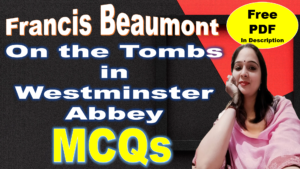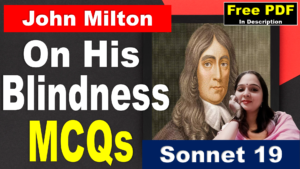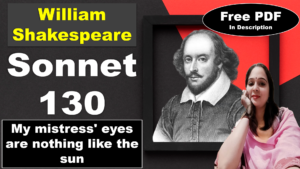The Garden by Andrew Marvell Explanation
First Stanza
How vainly men themselves amaze
To win the palm, the oak, or bays,
Explanation
This couplet introduces the poem’s theme of questioning human pursuits. The speaker criticizes the “vanity” of men who strive for external rewards like “palm” (victory), “oak” (strength), or “bays” (fame).
Poetic Device
Metaphor: “palm, the oak, or bays” are not just literal plants but metaphors for victory, strength, and fame, respectively.
And their uncessant labours see
Crown’d from some single herb or tree,
Explanation
This couplet expands on the first, suggesting that these prestigious rewards are ultimately fleeting and insignificant compared to the simple beauty of nature (“single herb or tree”).
Poetic device
Enjambment: The continuation of the sentence without a pause from the first line to the second creates a sense of flowing thought and emphasizes the unexpected nature of success.
Whose short and narrow verged shade
Does prudently their toils upbraid;
Explanation
This couplet further emphasizes the superiority of nature. The “short and narrow” shade of the tree, a symbol of nature’s limited lifespan, “prudently” criticizes their endless “toils” for fleeting rewards.
Poetic Device
Personification: The shade of the tree is given human qualities like “prudently” to emphasize its symbolic message of nature’s critique on human ambition.
While all flow’rs and all trees do close
To weave the garlands of repose.
Explanation
This final couplet offers a contrasting image. While humans toil, nature creates “garlands of repose,” suggesting peace and tranquility found in embracing nature.
Poetic Device
Imagery: “garlands of repose” creates a vivid picture of nature offering peace and tranquility, contrasting with the toil and striving of humans.
Metaphor: The flowers and trees weaving garlands are metaphorical for nature’s ability to create beauty and serenity.
Personification: Flowers and trees are personified as actively participating in the act of weaving garlands, emphasizing the interconnectedness and unity of nature.
Second Stanza
Fair Quiet, have I found thee here,
And Innocence, thy sister dear!
Explanation
In these lines, the speaker exclaims that he has found “Fair Quiet” and its dear sister, Innocence, in the garden. The poet personifies these abstract concepts, suggesting that peace and innocence are present in the solitude of nature.
Poetic Device
Personification: Both “Fair Quiet” and “Innocence” are given human qualities, emphasizing their desirability and suggesting they exist as tangible entities within nature.
Apostrophe: The poet directly addresses “Fair Quiet,” personifying it as if it were a tangible presence in the garden.
Mistaken long, I sought you then
In busy companies of men;
Explanation
The speaker acknowledges that he previously searched for these qualities in the wrong places, namely among people and societal pursuits.
Poetic device
Enjambment: The sentence runs across the line break, creating a sense of reflection and introspection.
Your sacred plants, if here below,
Only among the plants will grow.
Explanation
The speaker believes that true “sacred plants” representing “Quiet” and “Innocence” can only be found in nature, not in human society.
Poetic Device
Metaphor: “Sacred plants” represent the qualities the speaker seeks, not literal vegetation.
Society is all but rude,
To this delicious solitude.
Explanation
The speaker declares that human society is fundamentally incompatible with the “delicious solitude” found in nature.
Poetic Device
Oxymoron: “Delicious solitude” combines opposite ideas (deliciousness and solitude) to emphasize the paradoxical appeal of being alone in nature.
Personification: Society is personified in the poem. The speaker suggests that ‘Society is all but rude, To this delicious solitude’, attributing human characteristics to society.
Third Stanza
No white nor red was ever seen
So am’rous as this lovely green.
Explanation
The speaker marvels at the beauty of nature, specifically focusing on the color green. He claims it surpasses any human creation of white or red, often associated with purity and passion, respectively.
Poetic Device
Simile: “So am’rous as this lovely green” compares the color green to the intensity of love, suggesting its captivating and sensual allure.
Personification: Green is implicitly endowed with the quality of being “am’rous,” further blurring the lines between nature and human experience.
Fond lovers, cruel as their flame,
Cut in these trees their mistress’ name;
Explanation
The speaker criticizes the actions of “fond lovers” who carve their lover’s name on trees. He sees this as an act of cruelty against nature, driven by their fleeting passion.
Poetic Device
Juxtaposition: The contrast between “fond lovers” and “cruel” highlights the speaker’s disapproval of their actions.
Metaphor: “Flame” stands for their passionate but ultimately destructive love.
Little, alas, they know or heed
How far these beauties hers exceed!
Explanation
The speaker pities the lovers for their lack of understanding about the true beauty of nature, which far surpasses any human creation or affection.
Poetic Device
Enjambment
Fair trees! wheres’e’er your barks I wound,
No name shall but your own be found.
Explanation
The speaker vows to respect the trees and not mar their natural beauty with carvings. He emphasizes the inherent value of their own names, symbolizing their unique identity and connection to nature.
Poetic Device
Metaphor: The “wounds” refer to potential carvings, suggesting their harmfulness to the trees.
Personification: The trees in the garden are personified as well. The speaker says, ‘Fair trees! wheres’e’er your barks I wound, No name shall but your own be found’1, suggesting that the trees have their own identities.
Fourth Stanza
When we have run our passion’s heat,
Love hither makes his best retreat.
Explanation
This couplet suggests that when the intensity of human passion subsides, true love finds its solace and rejuvenation in nature. The speaker implies that nature offers a more enduring and authentic form of love than fleeting human emotions.
Poetic Device
Metaphor: “Passion’s heat” represents the intense but temporary nature of human emotions.
Personification: “Love” is given human qualities like making a “retreat,” suggesting its agency and connection to nature.
The gods, that mortal beauty chase,
Still in a tree did end their race:
Explanation
This couplet draws on mythology to further emphasize the connection between love and nature. The speaker references stories of gods pursuing mortal beauty, only to be transformed into trees (Daphne into laurel, Syrinx into a reed), suggesting that true beauty and love reside in nature itself.
Poetic Device
Allusion: References to specific myths (Daphne and Syrinx) enrich the meaning and connect the poem to broader cultural narratives.
Metaphor: The “race” can be interpreted as both the pursuit of love and the pursuit of mortality, further linking the two themes.
Apollo hunted Daphne so,
Only that she might laurel grow;
Explanation
This line elaborates on the previous allusion, specifically focusing on the myth of Apollo and Daphne. While Apollo chased Daphne for her beauty, she was transformed into a laurel tree, ultimately escaping his pursuit and becoming part of nature.
Poetic Device
Allusion: This couplet directly alludes to the myth of Apollo and Daphne from classical mythology.
And Pan did after Syrinx speed,
Not as a nymph, but for a reed.
Explanation
This line mirrors the previous one, referencing the myth of Pan and Syrinx. Instead of pursuing her as a human, Pan chases after her transformed form as a reed, again implying that true love resides in nature’s beauty rather than fleeting human form.
Poetic Device
Allusion: This couplet alludes to the myth of Pan and Syrinx from classical mythology.
Metaphor: The transformation of Syrinx into a reed is metaphorically described, emphasizing the symbolic significance of the natural world in mythological narratives.
Fifth Stanza
What wond’rous life in this I lead!
Ripe apples drop about my head;
Explanation
The speaker marvels at the abundance and generosity of nature, experiencing a joyful and fulfilling life within its embrace. The falling apples symbolize nature’s effortless provision and his connection to its rhythms.
Poetic Device
Imagery: Vivid description of ripe apples falling creates a sense of abundance and sensory delight.
The luscious clusters of the vine
Upon my mouth do crush their wine;
Explanation
The speaker continues to celebrate the sensory pleasures of nature, indulging in the sweetness of ripe grapes and their natural wine. This further emphasizes the bounty and satisfaction found in a connection with nature.
Poetic Device
Metaphor: “Luscious clusters” and “crush their wine” use figurative language to emphasize the richness and abundance of nature’s offerings.
Personification: The image of grapes “crushing their wine” suggests an active participation of nature in providing for the speaker.
Enjambment
The nectarine and curious peach
Into my hands themselves do reach;
Explanation
The speaker experiences an almost magical connection with nature, as fruits seem to offer themselves readily, highlighting the effortless bounty and harmony he finds in this environment.
Poetic Device
Personification: Fruits “reach” into his hands, further blurring the lines between human and nature and emphasizing its welcoming presence.
Enjambment: The sentence extends across the line break, creating a sense of continuous flow and ease in receiving nature’s gifts.
Stumbling on melons as I pass,
Ensnar’d with flow’rs, I fall on grass.
Explanation
The speaker describes a playful and carefree interaction with nature, stumbling on melons and falling on soft grass amidst flowers. This further emphasizes the joyful and uninhibited experience he finds in nature’s embrace.
Poetic Device
Metaphor: “Ensnar’d with flowers” metaphorically portrays the speaker being lovingly trapped by nature’s beauty, suggesting a positive surrender.
Sixth Stanza
Meanwhile the mind, from pleasure less,
Withdraws into its happiness;
Explanation
This couplet introduces a shift in focus from the sensory pleasures of nature to the internal world of the mind. While initially enjoying the physical delights, the speaker now turns inward to experience a deeper form of happiness.
Poetic Device
Juxtaposition: The contrast between “pleasure less” and “happiness” suggests a different kind of fulfilment found within the mind.
Personification: “Withdraws into its happiness” personifies the mind, allowing it to act and experience emotions like a human.
Alliteration: The repetition of the “m” sound in “Meanwhile the mind” creates a melodic quality and emphasizes the inward turn of the mind.
The mind, that ocean where each kind
Does straight its own resemblance find,
Explanation
This couplet expands on the metaphor of the mind, comparing it to an ocean reflecting everything in its depths. It suggests the mind’s ability to connect with and understand diverse experiences and emotions.
Poetic Device
Metaphor: The mind as an ocean continues across this line, enriching the image and its symbolic meaning.
Yet it creates, transcending these,
Far other worlds, and other seas;
Explanation
This couplet emphasizes the creative power of the mind. While it reflects external experiences, it also goes beyond them, crafting new worlds and realities that surpass the limitations of the physical world.
यह दोहा मन की रचनात्मक शक्ति पर जोर देता है। हालाँकि यह बाहरी अनुभवों को प्रतिबिंबित करता है, यह उनसे परे भी जाता है, नई दुनिया और वास्तविकताओं को गढ़ता है जो भौतिक दुनिया की सीमाओं को पार करती हैं।
Poetic Device
Imagery: “Far other worlds, and other seas” creates a vast and boundless image of the mind’s creative potential.
Annihilating all that’s made
To a green thought in a green shade.
Explanation
This couplet concludes the stanza with a paradoxical statement. The mind, in its creative process, can “annihilate” the external world, reducing it to a simple “green thought in a green shade,” symbolizing a state of pure contemplation and abstraction.
Poetic Device
Metaphor: “Green thought” personalizes the mind’s activity, portraying its thoughts as tangible entities.
Repetition: The repetition of the “green” in “green thought” and “green shade” creates a soothing and rhythmic effect.
Seventh Stanza
Here at the fountain’s sliding foot,
Or at some fruit tree’s mossy root,
Explanation
The speaker describes his preferred locations within the garden, seeking solace and connection close to nature’s sources of nourishment and life – the flowing water of the fountain and the roots of fruit trees.
Poetic Device
Imagery: Vivid descriptions of “sliding foot” and “mossy root” create a sense of coolness, peace, and connection to the earth.
Alliteration: Repetition of “f” sounds in “fountain” and “foot” adds a flowing and calming effect.
Casting the body’s vest aside,
My soul into the boughs does glide;
Explanation
This couplet describes a metaphorical shedding of physical constraints. The speaker imagines his soul leaving his body and entering the trees, symbolizing a deeper union with nature.
Poetic Device
Metaphor: “Casting the body’s vest aside” and “soul into the boughs does glide” are powerful metaphors for transcending physical limitations and achieving spiritual connection with nature.
Personification: “Soul” is given the ability to act and move, further blurring the lines between human and nature.
There like a bird it sits and sings,
Then whets, and combs its silver wings;
Explanation
This couplet continues the metaphor, depicting the speaker’s soul acting like a bird within the tree. It sings, whets its wings, and grooms itself, suggesting a sense of freedom and belonging within the natural world.
Poetic Device
Simile: “Like a bird it sits and sings” compares the soul’s actions to those of a bird, reinforcing the image of freedom and harmony with nature.
Metaphor: “Silver wings” further elevates the image and suggests a spiritual purity associated with the soul.
And, till prepar’d for longer flight,
Waves in its plumes the various light.
Explanation
This final couplet suggests a temporary nature to this experience. The soul enjoys its “flight” within the tree, basking in the light, but awaits an even greater journey beyond.
Poetic Device
Metaphor: “Longer flight” suggests a future spiritual journey beyond the current experience in the garden.
Imagery: “Waves in its plumes the various light” creates a dynamic image of the soul absorbing and reflecting the beauty of nature.
Eighth Stanza
Such was that happy garden-state,
While man there walk’d without a mate;
Explanation
This couplet establishes a sense of idyllic perfection associated with the Garden of Eden before Eve’s arrival. It emphasizes the happiness and serenity Adam experienced in this pristine and solitary state.
Poetic Device
Metaphor: “Garden-state” refers to both the physical location and the ideal spiritual condition Adam enjoyed.
After a place so pure and sweet,
What other help could yet be meet!
Explanation
This couplet raises a question about the potential limitations of even such a perfect environment. Despite the purity and sweetness of the Garden, the speaker wonders if something more could be “meet” or necessary for Adam’s complete fulfilment.
Poetic device
Metaphor: The phrase “a place so pure and sweet” metaphorically describes the garden, emphasizing its idyllic qualities.
But ’twas beyond a mortal’s share
To wander solitary there:
Explanation
This couplet provides an answer to the previous question. The speaker concludes that Adam’s solitary existence, despite the Garden’s perfection, was beyond the natural state for a “mortal.” Humans are inherently social creatures, and even paradise alone cannot fulfil the need for companionship.
Two paradises ’twere in one
To live in paradise alone.
Explanation
This concluding couplet uses paradox to further highlight the paradox of Adam’s situation. While the Garden itself is a paradise, the lack of companionship makes it feel like only half of a paradise, incomplete without another human being to share it with.
Poetic Device
Paradox: “Two paradises ’twere in one” emphasizes the contradictory nature of Adam’s experience, where paradise is both present and incomplete.
Ninth Stanza
How well the skillful gard’ner drew
Of flow’rs and herbs this dial new,
Explanation
In these lines, the speaker praises the skillful gardener for creating a new sundial using flowers and herbs. The term “dial” refers to a device that measures time using the position of the sun’s shadow, and in this case, it is fashioned from flowers and herbs. The poet emphasizes the artistry and proficiency of the gardener in crafting this unique timekeeping instrument.है।
Poetic Device
Metaphor: The sundial made of flowers and herbs is compared to a conventional timekeeping dial. This metaphor underscores the creativity and beauty of the gardener’s creation.
Where from above the milder sun
Does through a fragrant zodiac run;
Explanation
The lines describe how the sun moves through a fragrant zodiac, suggesting that the sundial is adorned with flowers arranged in the shape of the zodiac. The word “milder” may imply a gentle or pleasant sun, contributing to the overall positive and serene atmosphere of the garden.
Poetic device
Personification: The sun is described as “milder,” attributing human-like qualities to it, perhaps suggesting a benevolent or soothing nature.
And as it works, th’ industrious bee
Computes its time as well as we.
Explanation
This couplet introduces the idea that the industrious bee, while busy at work, also keeps track of time in a manner similar to humans. The bee’s activities are aligned with the operation of the sundial, creating a connection between the natural world and the measurement of time.
Poetic Device
Personification: The bee is described as “industrious,” attributing human-like qualities to emphasize its hardworking nature.
Simile: The comparison of the bee’s timekeeping to that of humans using “as well as we” reinforces the idea of a shared sense of timekeeping between nature and humanity.
How could such sweet and wholesome hours
Be reckon’d but with herbs and flow’rs!
Explanation
The final couplet reflects on the idea that the sweet and wholesome hours in the garden can only be truly appreciated and measured through the presence of herbs and flowers. The poet suggests that the beauty and tranquillity of the garden contribute to the perception and understanding of time.
Poetic Device
Imagery: The words “herbs and flow’rs” evoke a vivid image of a natural environment. This image contributes to the speaker’s point about nature being the ideal way to measure time.
Metaphor: The implicit comparison of time spent amidst nature to being “reckoned” with flowers and herbs suggests that these natural elements embody the essence of what makes an experience sweet and wholesome.










